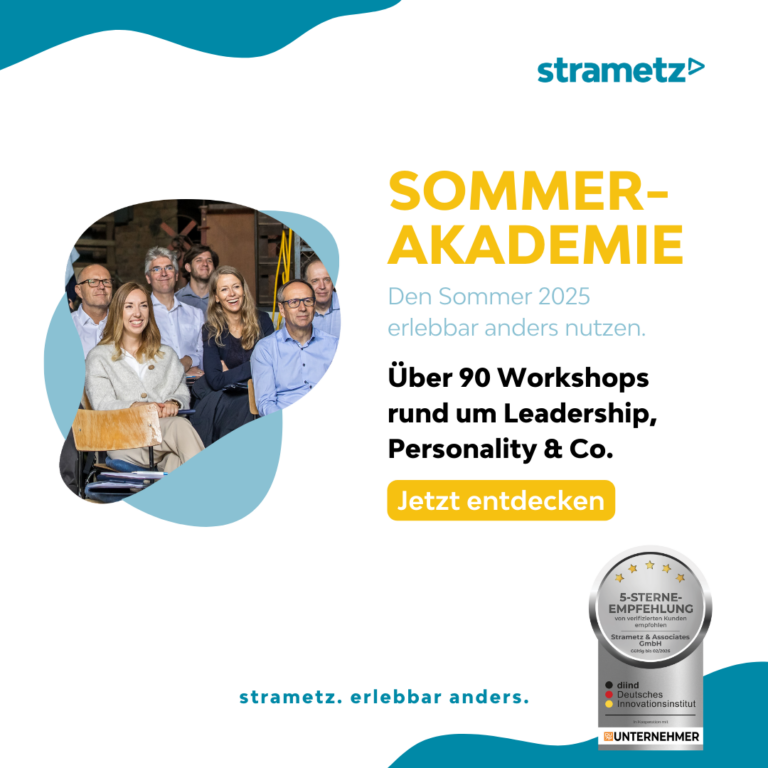What HR departments can learn from the animal world
When talking about potential and competence management, misunderstandings are inevitably inevitable. This is because there are very different ideas about what is meant by potential and competence, both in the academic debate and in entrepreneurial practice.
Without a common understanding of these two variables, it makes little sense to address the management of potential and competence. This is because, depending on how those involved interpret potential and competence, the management in this regard can and must also turn out differently.
In order not to drift into a theoretical debate on this topic that is largely useless for practice, the following remarks do not claim to be objectively correct in the scientific sense, but represent a perspective by practitioners for practitioners.
Especially for the application in practice, the question of distinguishing potential from competence is of fundamental importance. Lest the range of theoretical debates just mentioned be invoked, the following – deliberately non-scientific – example from the animal world will illustrate how potential and competence are understood here. If parallels to real existing companies or persons come to mind while reading, these parallels are purely coincidental.
Overcoming distance in the assessment center: Penguin, snail and cheetah in the race for the next career step
A penguin, a snail and a cheetah are invited to the assessment center. As is usual in such procedures, exercises are used to find out how good each candidate is. After all, nothing less than the next career step is at stake, with the prospect of a position as a “distance-crosser.” For cost reasons, the HR department has decided that the assessment center will consist of only one exercise: All three candidates are to cover a distance of 50 meters as quickly as possible on a level path.
For the managers who act as observers at this assessment center, it is already clear before the exercise who will come out on top. This is because their many years of experience have given them a good feel for the suitability of candidates for certain tasks. However, in order to give all candidates the same opportunities and not face accusations of bias, managers adhere to the prescribed assessment process. The exercise starts, and the candidates cover the distance as well as anyone can. For reasons of equal opportunity, it is of course necessary to wait until all candidates have completed the exercise, even if it is already apparent in the meantime that it makes no sense in terms of common sense. And so the assessment center drags on for several days until even the snail could complete the exercise.
The observers’ task in the assessment center is now to rate the competence of all three candidates on a scale of ten – ten is good, one is bad. The key behavioral anchor is “… was able to successfully overcome the distance”. The Cheetah is rated an average of “8” because there was a hint in advance not to rate too harshly, but not too favorably either. After all, the penguin has already mastered the distance on the first day and gets the competence value “5”, because there was an even worse participant. The snail is rated “2” because it made it, after all – and it probably had a bad day, to its credit.
After the averages of the ratings are confirmed to be mathematically correct, the HR department announces the result. Even if some HR representatives don’t feel good about the outcome, HR is obligated to act in a politically correct manner in accordance with compliance. Accordingly, diplomatic wording is used:
“All three candidates successfully completed the assessment center. The competency average score for this event was 5.0. Candidates who achieved a result below this average score will receive training as support to enable them to work effectively on their areas of development as they settle into their new position.”
Both the penguin and the cheetah and even the snail demonstrated the “overcoming a distance” competency, to varying degrees, but all were able to complete the exercise. Competence is generally understood as a consciously or unconsciously retrievable ability to behave in a goal-directed manner, whereby this goal-directed behavior can be observed and evaluated on the basis of behavioral anchors.
Competence management as a central field of action for future-capable HR departments
In recent years, the concept of competence has increasingly become the focus of quality standards, because the increasingly confusing educational landscape and globalization make it almost impossible to assess which job-related skills a person has or does not have on the basis of existing educational degrees or qualifications.
By requiring companies’ quality standards to introduce and continuously implement competency management, the aim is to ensure that the required skills for all business processes and workflows are identified, reviewed, managed and evaluated.
In the consulting landscape and among providers of related IT solutions, a distinction is sometimes made between the terms “competencies,” “skills,” and “capabilities,” but in practice this is largely a theoretical exercise without significant added value. Whether competence, skill or ability – the basis for a functioning competence management is the precise definition of the individual competences, their clear differentiation from each other and the possibility of structuring the respective competence at different levels (competence level) with definable behavioral anchors. With a correspondingly large number of competencies, this can involve a lot of effort. But this is the only way to reliably determine competence profiles of persons and tasks or positions. These profiles and the associated matching can then be used in a variety of ways, for example in personnel selection processes, staff development, talent development, career counseling, etc.
Working with competency profiles has the advantage of minimizing subjective assessments, snapshots, nose factors, and gut feelings and evaluating them using fact-based competency definitions. Creating a purely objective competency system is the goal, but in reality competencies will not be able to be assessed with mathematical exactness, even if the numerical values in assessment center result reports suggest this. Nevertheless, the more precise and selective a competence system is, the less susceptible it is to subjective interpretations.
Once such a system of individual competencies with descriptions, competency levels, profiles, etc. has been created, it makes sense not to leave these competencies to run themselves, but to manage them, i.e. to control them in a targeted manner. Competence management can be used, for example, to identify at an early stage competence deficits in a team or an entire workforce that pose a risk to corporate strategy. In addition, competency management can be used to develop targeted competencies in quantity and quality to match the requirements of the company’s processes, for example to avoid “training that misses the mark”. In addition, there are many other fields of application, ranging from strategic corporate alignment to operational personnel development and recruiting.
Recognizing potential: The key to successful competence management in the company
Now back to our animals. If – as exaggerated in this example – behavioral anchors for competence are not described precisely and are only assessed on the basis of an exercise, even the best competence management system is of no help. The fact that the above-described gut feelings of the observing managers were not taken into account in the assessment center is often related to the fact that no meaningful distinction is made between potential and competence. Anyone who understands potential and competence as terms with a large intersection or as a gray area with different shades, no matter how good the scientific justification, will have difficulties in practice at the latest. A well-intentioned conflation of the two variables helps neither the individuals concerned nor a company.
While it is objectively true that all three animals demonstrated competence in covering a distance by land, albeit at different levels, this finding is of little help in practice. Insofar as training courses are then offered to increase competence, this sounds funny at best, rather sarcastic, in relation to the snail. When something like this takes place in lived corporate practice, it’s no longer funny. For the person in question it is a pain and for the company it is money thrown away.
Again, what seems simple in the case of animals requires well thought-out, multidimensional analyses in the context of the world of work. Different potential factors are considered depending on the task or job profile(s) and the competence profile(s) derived from them. While the potential of the penguin and the snail for the competence “short-distance running” can be assessed on the basis of leg length and anatomy, in the entrepreneurial context potential factors from the area of traits, values, drivers, cognitive abilities and affinities come into play. In order to be able to make a reasonably reliable assessment of the potential, it should be considered from several perspectives, i.e. on the basis of different potential factors.
How looking at potentials contributes to more meaning and success
So what is potential management? Similar to the competence management described above, potential factors can also be defined, structured, scaled and arranged in a logically structured overall system. Potential management starts where the possibilities for competence development based on the potential profiles are looked at. However, potential profiles do not guarantee successful competence development, but they significantly increase its probability.
A cheetah has an exceptionally high potential for short distance sprints. But if this cheetah is locked in a cage in the zoo, it will not be able to develop its potential. In this respect, potential management can identify promising competence development prerequisites, but even the best potential management cannot forcibly open cages or conjure up changed framework conditions. Sometimes, however, potential management helps to convince a zoo director, based on facts, that the cheetah is better off in the savannah than in a cage. Then zoo directors may free animals from obstructive environments and release them where their potential can best develop.
Potential management can thus be understood as “species-appropriate” employee development and promotion. Then, when a penguin applies for the short-distance runner position, companies don’t need to hold an assessment center to embarrassingly display the penguin’s job-related shortcomings for all to see. Potential-oriented employers offer such a penguin applicant a potential analysis, create a potential profile, and then use their potential management system to see which target profile(s) are best suited for the penguin and advise him or her from a potential perspective: What competency(ies) could this penguin develop with joy, ease, and success? In which jobs can these competencies be found?
When the penguin realizes that it is not about his deficits, but about his potential development, then potential and competence management are not just another HR tool, but a culture of appreciation and humanity. Penguins, snails, and cheetahs treated this way by their employers have significantly lower turnover risk, significantly lower sickness rates, and significantly higher productivity. If competence management is then based on such potential management, personnel development not only makes sense, but also brings about a high return on investment in business terms. And the animals are happy and work highly motivated.
Book: “Innovative Potential and Competence Management” by Manuel Schuchna
If you would like to learn more about potential and competence management, you will find further information in the book of the same name by Manuel Schuchna, published by Schäffer-Poeschel Verlag : “Innovatives Potenzial- und Kompetenzmanagement: Mit Affinitätenprofilen zu besseren Personalentscheidungen”.
Contact now
Are you interested in the topic of potential and competence management in your company? Then please feel free to contact us. We support you as experts for the potentials and competencies of your applicants, employees and managers.










